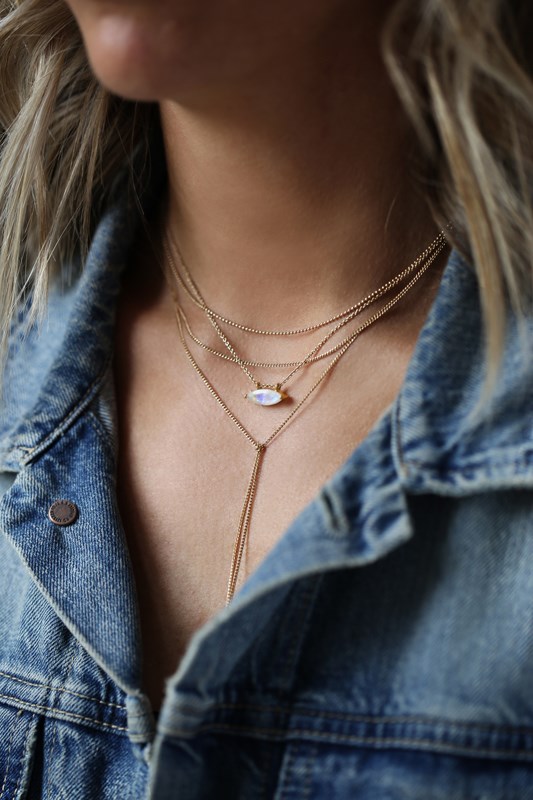If you’re still browsing the high street for your jewellery, you’re missing a trick. As with everything else, smart shoppers now are hunting the coolest, most unusual and prettiest pieces online – specifically, on social media. The dominant platform? Instagram.
Local stars
Vancouver-based designer Leah Belford founded Leah Alexandra (LeahAlexandra.com) more than 10 years ago, specialising in gemstone and pearl jewellery. She started her first Instagram account in 2010, when the platform launched.
“I was drawn to it because I’m a visual person,” she says. “Initially I had an account for personal use and then I started to feature my jewellery more often.” Now, she has almost 30,000 people following her on Instagram (@leahalx_jewelry).
New to the industry are Vancouverites Jeremy and Braeden Ethier, aged 20 and 15 respectively, who started their line, Medea Jewelry (MedeaJewelry.com), a few months ago when they spotted an opening in the market for quality charm bracelets aimed at millennials. Social media is the main marketing platform for the brand and it already has more than 16,000 followers on Instagram (@MedeaJewelry).
“We spent months building our social media audience before we even had products to sell,” says Jeremy.

How to make friends and influence people
Followers are built up through influencers – celebs, bloggers and Instagrammers who receive products or cash to post about your brand.
“We embrace our ambassadors and love to share these collaborations,” says award-winning British designer Imogen Belfield (@ImogenBelfield), whose “rockesque” pieces are sold here at Wardrobe Apparel (WdrobeApparel.com). “It enables our product to be seen internationally – new work as well as classic pieces that are worn time and again.”
How is it set up? “Influencers with 500,000 or one million followers will negotiate and want cash, which is not something we’re engaging with because we don’t have the budget,” says Ethier. “But if we approach 10 influencers, usually four or five will agree to post something for a free bracelet.”
Belford is very selective about who she’ll work with and how.
“I have my aesthetic, and I understand straightaway from looking at an influencer’s posts whether they’re right. I have a visual guideline that demonstrates how I need the piece to be shot –with detail, in focus and so on.”
Managing your feed
Belford says that the posts that work best for her are close-up, detailed shots. “If they just wear it as part of an outfit, it won’t help,” she explains. Ethier believes it’s best to place products in their lifestyle context. “For example, pictures of our ‘dumbbell’ bracelet with someone holding a healthy acai bowl would show a boost in sales because that picture represents the lifestyle behind the product,” he explains. For Belfield, lifestyle shots and images of the pieces being worn work best.
“Shots that showcase the pieces in the London landscape, in which they are created, do well too,” she says.
All agree that one or two pictures a day is best.
“Now, with Instagram Stories, people’s feeds are getting clogged up and I’ve noticed a decline in interaction because there’s too much content. It makes me prize quality over quantity even more,” says Belford. She is also conscious of the flow of her Instagram feed.
“I like to have a good grid with nine squares that work together the right way,” she says. “I sprinkle in lifestyle shots so it’s not all product shots.”
Posts mean sales?
Both Belford and Ethier say social-media posts translate to sales. Ethier says that 60 per cent of sales through his website come directly from Instagram. Belford’s work has been featured in titles like Vogue, but she still values social media.
“Magazines have been great for building brand value, whereas Instagram drives sales conversion,” she says. “Even if it’s not immediately to my website, it’s part of the bigger picture, for example sending customers into stores to find an item they saw in a post, or inspiring people how to layer the jewellery they already have.”
And why does she think jewellery does particularly well on social media in comparison to other fashion items?
“It looks great close up in this tight square – particularly my pieces, which are delicate. It allows you to see detail and grabs the attention.”
With small brands, it also allows for personal interaction with the designer.
“It builds brand loyalty because people feel like they know you,” says Belford. “It’s a privilege that someone tunes into something of yours every day.”



